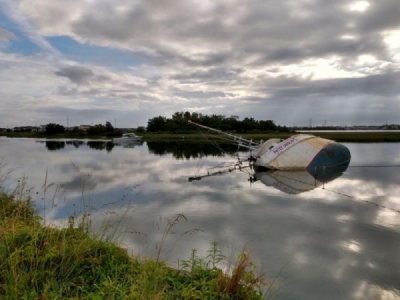
Posted on November 10, 2020
MOREHEAD CITY — A Carteret County-based environmental nonprofit and a state agency have received nearly $2 million for marine debris and derelict vessel removal.
According to an announcement Oct. 22 from the N.C. Coastal Federation, a nonprofit dedicated to conserving and restoring the state’s coastal environment, the N.C. Division of Coastal Management, in partnership with the NCCF, received nearly $2 million dollars in funding from the Natural Resources Conservation Service’s Emergency Watershed Protection Program for the removal of marine debris and abandoned and derelict vessels.
DCM’s Coastal Reserve-and National Estuarine Research Reserve program is one of the many public trust areas along the coast that will benefit from the cleanup effort.
DCM Coastal Reserve Program Central Sites Manager Paula Gillikin said this project “in concert with others being conducted simultaneously, will culminate in the largest organized public lands debris removal effort in North Carolina’s coastal history.”
According to the NCCF in its announcement, local fishermen have been combing through public trust shorelines and into hidden marsh areas of dredge spoil islands to remove large deposits of pressure treated wood, plastic and polystyrene floats and other debris from docks and waterfront structures damaged by Hurricane Florence. Coastal restoration specialist Sarah Bodin is the federation’s lead on the cleanup project and said three marine debris cleanup crews have been working in the central region in Carteret and Onslow counties since July.
“The crews are covering Rachel Carson (National Estuarine Research) Reserve, Hammocks Beach State Park and the surrounding dredge spoil islands,” Ms. Bodin said.
At the reserve, a four-person cleanup grew began work Aug. 17, according to Ms. Bodin. As of last week, the crew had removed 62,060 pounds, or 31 tons, of debris.
“A large portion of the debris that’s been removed so far is pressure treated wood, dock pieces, large 20-foot pilings, floating dock pieces and consumer debris,” Ms. Bodin said.
 A pile of pressure-treated wood collected by the N.C. Coastal Federation awaits removal from Rachel Carson National Estuarine Research Reserve. (Contributed photo)
A pile of pressure-treated wood collected by the N.C. Coastal Federation awaits removal from Rachel Carson National Estuarine Research Reserve. (Contributed photo)Field crews have collected almost 74 tons of debris since July from the reserve, as well as the Permuda Island and Masonboro Island reserves and Hammocks Beach State Park.
Federation regional project lead Ted Wilgis added it’s important to realize the simple things people can do to reduce marine debris at home and work.
“During this busy hurricane season, everyone can help reduce property damage and the amount of debris entering coastal waters by following tips such as ensuring trash and recycling cans are empty and secure prior to storms,” Mr. Wilgis said.
Most of the debris being collected are large pieces of debris, like lumber and floats from broken up docks and piers.
Sneads Ferry fisherman Joe Huie said residents and property owners “should really pay attention to how these things are being built and maintained along the coast.”
“It would probably be cheaper for the property owner and the public to build these more solid than to replace them with every storm,” he said.
Mr. Wilgis said the federation “encourage(s) owners of these damaged structures to try to secure them as best as possible until they can be removed or repaired.”
Many vessels have also been scattered along the coast are now considered abandoned and derelict. In July, Gov. Roy Cooper approved final legislation that allowed the N.C. Wildlife Resources Commission to remove the derelict vessels.
Vessel removal by specialized contractors is anticipated to begin in late November. The state-hired contractors will focus on the derelicts from named storms. The WRC will use an additional $1 million in state appropriations to remove vessels left by hurricanes Florence and Matthew.
The federation is also receiving funding from the National Oceanic and Atmospheric Administration Marine Debris Program and the National Fish and Wildlife Foundation Emergency Response Marine Debris Program, building on additional state appropriations and funds from the NOAA Marine Debris Program in 2019 that resulted in more than 315 tons of debris and several vessels removed.
People visiting coastal reserves and other public lands can help by picking up trash when it’s safe to do so and disposing of it properly. Visitors are encouraged to share their finds by tagging “@debrisfreenc” on social media.
More information on this project and the N.C. Marine Debris Action Plan can be found online at nccoast.org/protect-the-coast/marine-debris/.
Reporter Mike Shutak contributed to this article.
Source: carolinacoastonline





